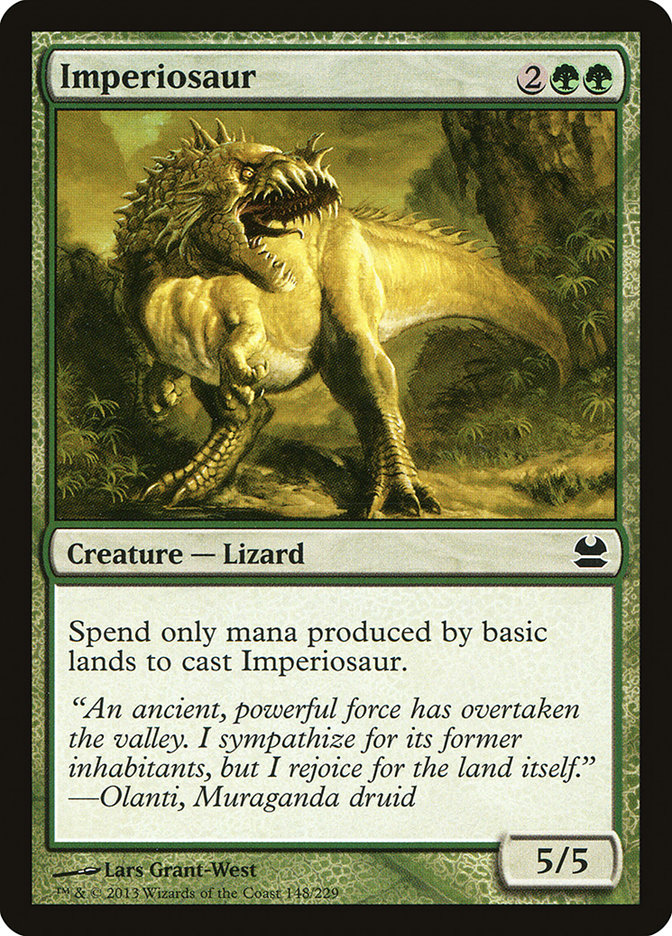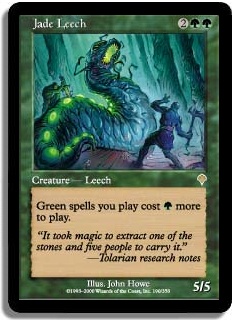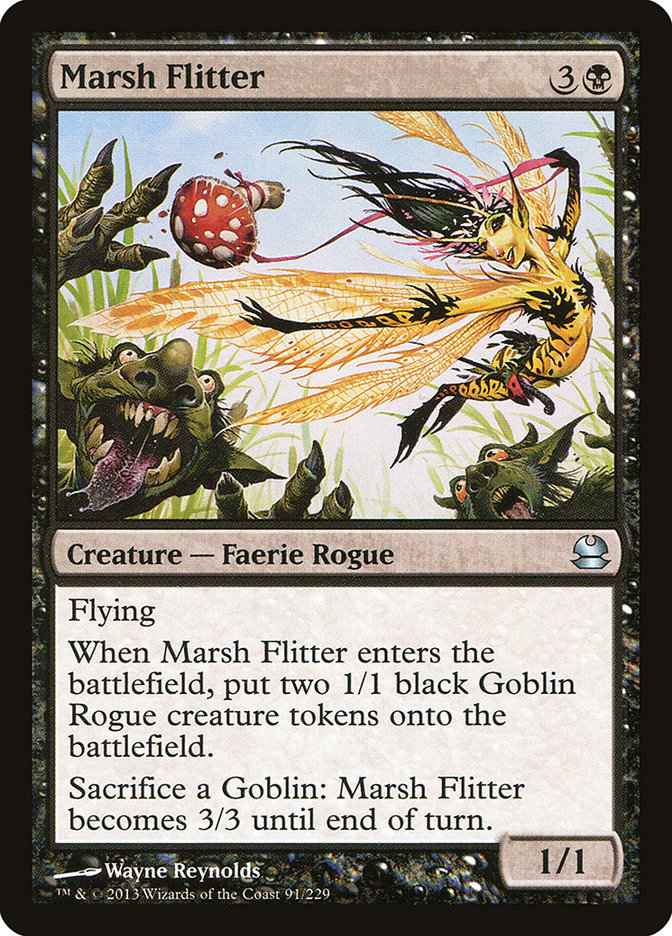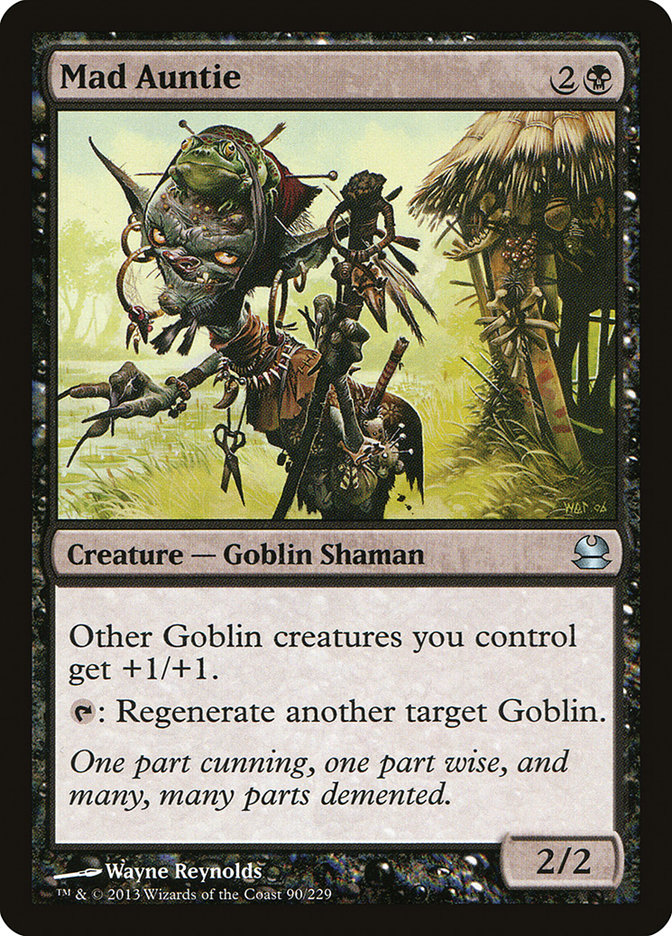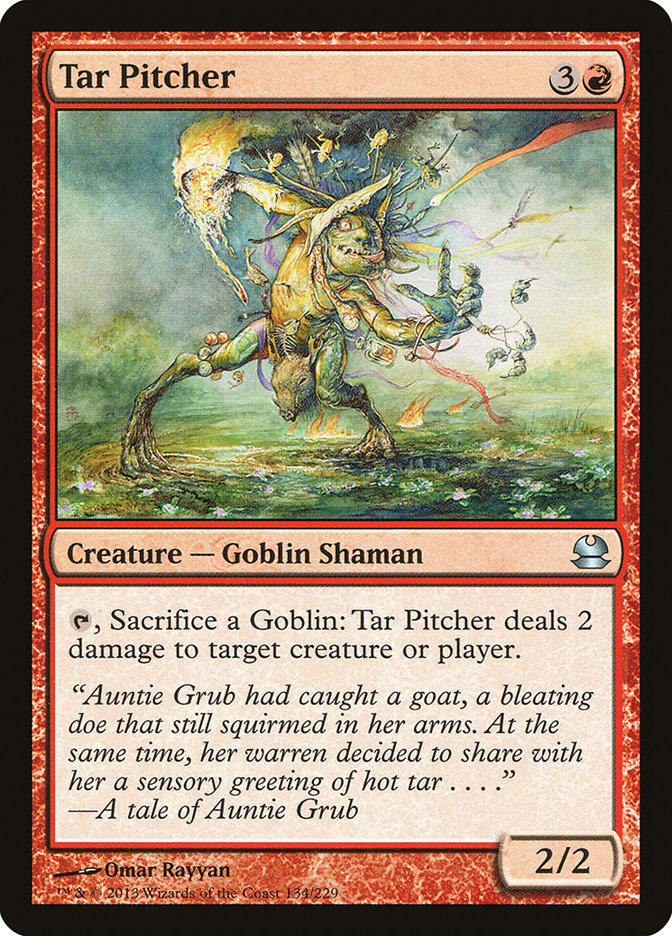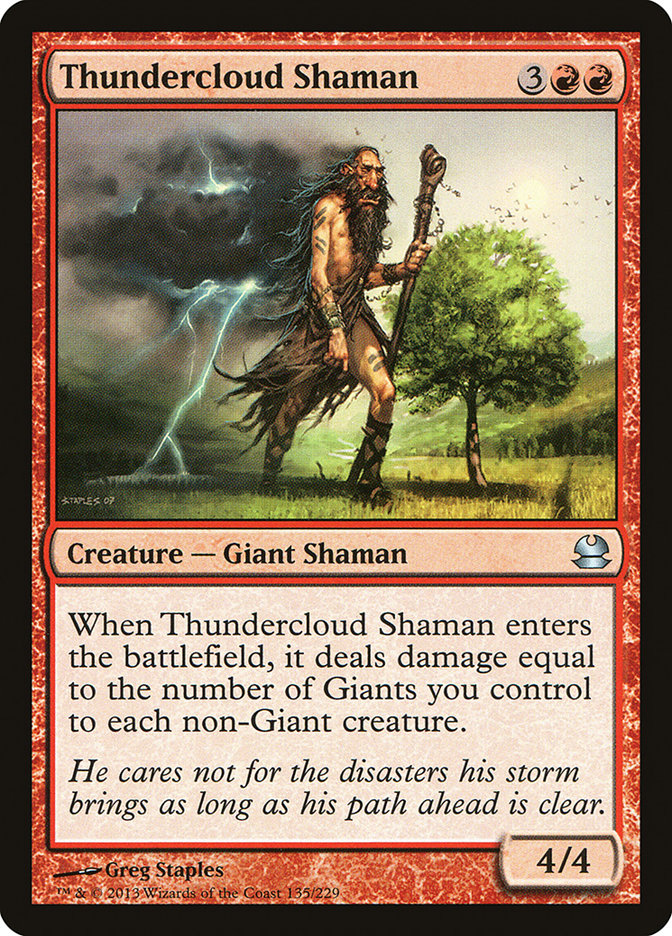I’ve been skeptical about Modern Masters since I first heard about the concept for the product. The idea of creating a limited print run set in order to increase the number of scarce older cards in circulation without significantly damaging the secondary market value of those cards seems overambitious at best and downright impossible at worst. Wizards is attempting to traverse an incredibly narrow tightrope of supply and demand with tremendous pitfalls on either side. Too much Modern Masters in the system risks alienating established players by devaluing their collections, while too little frustrates newer players who are still unable to get their hands on Modern staples like Tarmogoyf and Dark Confidant despite the new set.
Originally, I wasn’t planning on playing much with Modern Masters. The high MSRP (manufacturer’s suggested retail price) of the set alone makes drafting it prohibitively expensive for most players. When the hype surrounding the set inflated the actual price of packs to $10 or more, I figured I wasn’t going to bother with it at all, especially since Grand Prix Las Vegas—the one GP using the set—was scheduled to conflict with Electric Daisy Carnival, an electronic music festival I have attended every year since I moved to the West Coast.
Then the World Championship happened. Modern Masters Draft is taking the place of Cube this year as the second draft format of the sixteen-player championship tournament (known last year as the Players Championship). With a full quarter of the biggest tournament of the year featuring the format, there really wasn’t any choice—I was going to have to learn to play Modern Masters whether I liked it or not.
And you know what? I like it. I really, really like it.
I’ve done a handful of Modern Masters drafts so far, and it’s already one of my favorite Limited formats in recent memory. There is an incredible breadth of different possible strategies, each with remarkable depth to them. That’s the hallmark of a good draft format in my mind—a wide variety of archetypes to explore with many potential ways to build all of them.
And the format has true character, too. As someone who has played Magic since the dawn of time, I can really appreciate the juxtaposition of old cards in new contexts. It’s really cool seeing the interplay of the Affinity cards from the original Mirrodin block with the new colored Esper artifacts from Shards of Alara, for instance.
The very first deck I drafted in the format had Arcbound Ravager and friends alongside Court Homunculus and Faerie Mechanist, and it was downright awesome. It didn’t hurt my perception of the format that we opened a foil Tarmogoyf in our second draft, which we immediately sold to more than cover the cost of packs for everyone. Some of the cards are even pretty much new to me since I wasn’t playing during Time Spiral or Lorwyn blocks, so I’m having the experience of seeing and playing with a bunch of cards for the first time.
So while Modern Masters may be outrageously expensive to draft, it’s also outrageously fun. When I asked on Twitter for suggestions on what to write about this week, Modern Masters Limited was far and away the most popular answer. I haven’t done a ton of drafts yet, but I have played and watched enough that I feel like I have at least a reasonable grasp of the format, so I want to use this opportunity to share with you what I’ve learned.
The most important thing to keep in mind in Modern Masters is that you’re drafting a deck, not a color combination. In many formats, you can get away with just choosing a couple colors and picking "good cards" in those colors to more or less cobble together a good deck. This was pretty much the case in Return to Ravnica and Gatecrash Draft—most of the best cards were gold, and most of the gold cards of the same guild functioned along the same basic theme, so you couldn’t go too far wrong by just picking a guild and sticking to it. Things got a bit more complicated with the introduction of Dragon’s Maze because of the absence of half the guilds in some packs, but it was a fine basic formula.
In Modern Masters, however, it’s much more important to identify what strategy you’re drafting because the value of cards varies wildly from one archetype to another. It’s much more like Cube Draft in that way—the best decks are going to bear a lot more resemblance to Constructed decks than to the average Limited deck. To that end, I want to talk about the major archetypes you can expect to see in the format and go over their strengths and weaknesses as well as some of the most important cards to look out for.
Faeries
I’m going to start at the top. From my experience so far, Faeries seems like the strongest of the archetypes in Modern Masters Limited for much the same reason that it was such a dominant presence in the Standard format for so long. No, not Bitterblossom, but rather exceptional flexibility in the role it takes on in a given matchup. Against aggressive decks, Faeries can take on the role of control, with cards like Peppersmoke, Dreamspoiler Witches, and Thieving Sprite providing you with ways to leverage card advantage against anyone trying to attack you with small creatures and Spellstutter Sprite making life difficult even early on against opponents with a lot of cheap spells.
Against slower decks, many of those same cards put pressure on your opponent and surgically deprive them of their bombs, especially backed up by countermagic like Logic Knot and even Traumatic Visions. You can swarm down your opponents with an armada of fliers or pick them apart over a long game with card drawing from the likes of Mulldrifter and Careful Consideration.
You also have access to many rare bombs, like Cryptic Command and Vedalken Shackles, that can easily dominate games. Be sure to pick up bounce, counters, or cards like Rathi Trapper because Penumbra Spider can put a serious damper on your day.
Key Cards
Spellstutter Sprite
Thieving Sprite
Dreamspoiler Witches
Peppersmoke
Pestermite
Marsh Flitter
Rebels
Rebels were by far the dominant archetype in their original set, and while we haven’t gone back as far as Mercadian Masques with Modern Masters, they still show some inklings of their former power. Rebels can truly punish any opponent who is trying to play a slower game, particularly one based on one-for-one removal, by simply chaining together searchers and making it impossible for their opponent to keep up with a steady stream of creatures.
These aren’t your grandpa’s Rebels, either—we’re not digging up Fresh Volunteers and Task Forces. There is an incredibly wide range of very powerful Rebels in the set, including a removal spell in Bound in Silence, board control with Rathi Trapper, and the would-never-get-printed-in-a-new-set Saltfield Recluse. The new school Rebels also get to play with Changelings, most notably Avian Changeling, which along with Amrou Seekers gives the Rebel player a great way to break through stalled boards.
The big question in drafting Rebels is how aggressively to take the enablers. Your deck starts to really take off once you have three or four of the searchers, but you need good things to find with them as well. My inclination is that you’re better off starting with the cards with wider utility, like Rathi Trapper and Bound in Silence, just in case you find yourself cut off from Rebels and need an exit strategy.
Key Cards
Amrou Scout
Blightspeaker
Amrou Seekers
Bound in Silence
Saltfield Recluse
Rathi Trapper
Affinity
As I mentioned in the intro, the very first deck I drafted in the format was Affinity. The great thing about Affinity in Modern Masters is that the best cards in your deck aren’t very appealing to other players, so you’ll have the opportunity to pick them up very late. The bad thing is that your deck is very reliant on having a critical mass of artifacts to function; if you find yourself competing with too many other players at the table, you’ll end up with a deck full of 1/1s and incredibly inefficient 4/4s as you struggle to make use of your Arcbound Workers and Myr Enforcers.
What this means is that you really don’t want to go all-in on Affinity early without a very clear signal or a real bomb like Arcbound Ravager or Auriok Salvagers forcing your hand. Some of the cards that are good for your deck, like Sanctum Gargoyle, Executioner’s Capsule, and the Spellbombs, are good in other decks, so the most likely way to end up in Affinity is to just backdoor into it after picking up a few of these and noticing quality artifacts going late.
There are two directions to go with Affinity in the format: aggressive Court Homunculus decks and grindy Faerie Mechanist / Sanctum Gargoyle decks. So far, my only real experience has been with the former, and my deck worked out great because I had Arcbound Ravager, Salvagers to back it up, and some tools for long games. I’m inclined to think that the grindier decks are more likely to do better in the long run, though, since the faster decks seem likely to get brickwalled by cards like Penumbra Spider—a theme that we’ll see come up again.
One last interesting point is the overlap between Affinity and the Domain decks. Cards like Skyreach Manta and Etched Oracle have the potential to be powerful in Affinity with the right mana fixing, such as Paradise Mantle or just the land cyclers. There are a lot of individually powerful cards for the deck in various colors, like Tidehollow Sculler and Shrapnel Blast, so there’s something to be said for playing multicolor Affinity and taking these cards relatively high. My first deck had a single Island and Mountain to support two Faerie Machinists and a Shrapnel Blast while being base B/W, and while I felt a bit mana heavy with my land cyclers, it certainly worked out in the end.
Key Cards
Aether Spellbomb
Pyrite Spellbomb
Arcbound Worker
Arcbound Stinger
Bonesplitter
Executioner’s Capsule
Faerie Mechanist
Myr Enforcer
Sanctum Gargoyle
Court Homunculus
Domain
While I feel like Faeries and perhaps Rebels are better decks, Domain is my favorite deck I’ve drafted so far in Modern Masters. The mana fixing in this format is perhaps the best that has existed in any Draft environment I’ve ever played, with Kodama’s Reach and Search for Tomorrow headlining an assortment including every basic land cycler and Vivid Land, though the latter are uncommons. Not only are the enablers great, but the payoff is also huge, with Skyreach Manta the big one at common—a 5/5 flier for five is nothing to take lightly. Drag Down and Tribal Flames are fine pickups as well, along with Etched Oracle at uncommon.
The most exciting part of playing Domain, however, is the fact that you can play virtually any awesome card that you open! It doesn’t matter what Kamigawa Dragon you get daggered with in your mythic slot—you can put it in your deck! Vedalken Shackles? Cryptic Command? We can make those work too! I tend to think that G/U is the best base color combination for Domain as it is since Traumatic Visions is far and away the best of the land cyclers (with Gleam of Resistance pulling up the rear by a large margin). Blue also has the best card-drawing options, like Careful Consideration and Petals of Insight, which is important because your deck has a high density of mana generation effects and needs ways to dig for your bombs.
On top of the sweet multicolored action, you also get the option to just play with giant monsters! Green has some incredible fatties in this set, headlined by Imperiosaur as a 5/5 for four mana. I remember when Jade Leech was a rare that people were excited to open—hell, I played it in a Constructed deck way back when, even one that took me to the Top 8 of a Pro Tour!
Key Cards
Kodama’s Reach (by FAR the most important!)
Search for Tomorrow
Drag Down
Skyreach Manta
Etched Oracle
Tribal Flames
WHATEVER BOMBS YOU WANT WHEEEE!
Storm
This is not a deck I have successfully drafted myself, but it’s one that I have seen be very effective. The Storm decks that I have seen have frequently been hybrids with another of the spell-based decks, like Dampen Thought, since both strategies encourage you to have a high density of cheap cards in your deck. I have also seen Affinity/Storm hybrids because Etherium Sculptor plus Spellbombs is a good way to play a lot of spells in a single turn without using much mana.
The real incentive for Storm is Empty the Warrens. While Grapeshot exists and is a reasonable card, without the cantrip and ritual density that you have in Constructed, it’s hard to generate enough storm to outright kill your opponent with Grapeshot. The exception is if you manage to pick up a Pyromancer’s Swath, at which point Grapeshoting your opponent to death becomes much more reasonable. The more likely scenario, however, is that you’re going to try to string together some spells early on to spit out eight-to-twelve Goblins and maybe finish your opponent off with Grapeshot if they’re able to stabilize.
Key Cards
Empty the Warrens
Grapeshot
Peer Through Depths
Reach Through Mists
Petals of Insight
Pyrite Spellbomb
Aether Spellbomb
Manamorphose
Desperate Ritual
Grinning Ignus
Pyromancer’s Swath
Goblins
I have yet to see an effective Goblin deck. I do not know whether that is because the deck is weak or simply because it is not as appealing to draft for many players as the other archetypes. I don’t feel comfortable identifying the key cards in the deck as a result. I assume some combination of Marsh Flitters, Mogg War Marshals, Mad Aunties, and Tar Pitchers would make for a nasty brew, but I just have never seen it come together.
Giants
Fe-fi-fo-fum, Thundercloud Shaman is an un-comm-on. In my mind, that’s the biggest draw to drafting this strategy since the Giant is outlandishly powerful against a huge number of the potential decks you may face. It doesn’t hurt that you can also end up with a ton of huge creatures for cheap thanks to Blind-Spot Giant and Stinkdrinker Daredevil giving you the tools to have a massive board presence very quickly.
The biggest problem with Giants is how poorly it matches up against green decks. Your creatures are largely four power, so a single Imperiosaur can totally ruin your day. You can try to bash through with Ivory Giants, but many of your best creatures are nonwhite so it can be hard to use aggressively. Your best bet is probably trying to pick up some Blinding Beams, which is still as good a finisher now as it was back in its heyday.
The Giant deck probably leans more heavily on Changelings than any of the other tribal archetypes since Kithkin Greatheart, Blind-Spot Giant, and Crush Underfoot are so heavily reliant on having the right creature type to take advantage of them.
Key Cards
Thundercloud Shaman (the big boss man)
Thundering Giant
Stinkdrinker Daredevil
Avian Changeling
War-Spike Changeling
Kithkin Greatheart
Blind-Spot Giant
Crush Underfoot
Dampen Thought
Dampen Thought was the darling of Kamigawa Block Draft in much the same way Spider Spawning had a cult following in Innistrad. I didn’t play during that period, so I can’t speak to how effective it was, but frankly I’m hoping that it doesn’t turn out to be a popular or dominant archetype this time around. It isn’t terribly fun to play against someone who isn’t even operating on the same axis as you. Playing against Dampen Thought is much like playing against Burn in that all that matters is that they can assemble the appropriate amount of damage (or milling) before you kill them—it’s a simple race. Just how good the all-spell player is at racing is what determines how frustrating the deck can be to play against.
There are a few little facts that make me think Dampen Thought will have a tougher time winning now than it might have before, though. One is that creature quality is much higher in general—it’s a lot harder to race Imperiosaur than Kitsune Blademaster, for instance. Two is that overall card quality is also much higher in general, which means that your opponents are more likely to have playable cards sitting in their sideboard that they can board in to fatten their deck and make your job milling them much harder. I saw Sam Gomersall trying to figure out how to mill out an opponent who sideboarded up to 60 cards earlier today, and I can assure you it was not an easy route to victory.
Key Cards
Dampen Thought
Peer Through Depths
Glacial Ray
Reach Through Mists
Petals of Insight
Torrent of Stone
Hana Kami
Last and, as far as I can tell, least:
Dredge and Thallids
It’s possible these decks are good, but not only have I never seen anyone win with them—I haven’t seen anyone even bother to try. It’s possible that something like Worm Harvest is enough to make someone want to play Dredge and maybe there’s a busted Thallid deck out there just waiting to be found, but as far as I have been able to tell, no one is even looking. Have you had any success with one of these archetypes? What have you found to be the key cards and why? Let me know because I’m clueless.
Anyway, that’s it for this week. Whether you’re going to be among the thousands at the record-shattering Grand Prix Las Vegas this weekend or you just like lighting money on fire by cracking packs of Modern Masters and hoping to open a Tarmogoyf, I hope this was a useful overview of the format. I may or may not be back with another article next week since I’ll be staying in Vegas until next Wednesday and who knows whether I’ll be able to coherently string together sentences by then.
Until next time,
bmk



